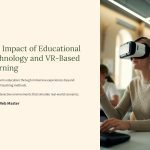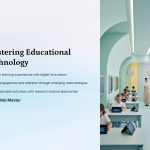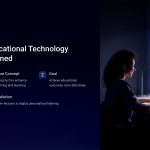 Virtual Reality (VR) is transforming the educational landscape by providing immersive learning experiences that go beyond traditional teaching methods. As technology continues to evolve, the role of VR in educational settings has gained considerable attention, particularly in educational technology (EdTech). In this post, we will explore how VR-based learning content is changing the way we learn, and the potential future of education with the integration of VR technologies.
Virtual Reality (VR) is transforming the educational landscape by providing immersive learning experiences that go beyond traditional teaching methods. As technology continues to evolve, the role of VR in educational settings has gained considerable attention, particularly in educational technology (EdTech). In this post, we will explore how VR-based learning content is changing the way we learn, and the potential future of education with the integration of VR technologies.
As the demand for more engaging and interactive educational experiences rises, educators are seeking innovative ways to enhance student understanding. VR technology offers an unparalleled opportunity for creating highly interactive and immersive learning environments that can simulate real-world scenarios, making learning more dynamic and accessible.
The advantages of VR-based learning content include the ability to provide hands-on learning experiences without the limitations of physical space, creating simulated environments for subjects such as history, science, medicine, and engineering. Furthermore, VR allows students to explore complex concepts in ways that were previously impossible in traditional classroom settings, offering more personalized learning paths.

The Role of VR in Enhancing Student Engagement
VR technology can be a game-changer in terms of boosting student engagement. Traditional methods often fail to keep students fully engaged, as passive learning environments can lead to boredom and lack of interest. VR, however, offers a highly engaging, sensory-rich experience that allows students to interact with their learning environment in real-time.
For instance, a VR simulation of the solar system enables students to explore planets and their moons up close, making the learning process both fun and educational. By incorporating such technology into classrooms, teachers can spark students’ curiosity, leading to increased participation and motivation.
Moreover, VR in education has been shown to improve learning retention rates. Studies suggest that students who experience learning content through VR tend to remember information longer compared to those who engage with traditional textbooks or videos. This is because VR activates multiple senses, providing a more impactful and memorable learning experience.

Overcoming Geographical and Resource Limitations
One of the most remarkable benefits of VR-based learning content is its ability to overcome geographical and resource limitations. In traditional learning environments, students often miss out on hands-on learning opportunities due to limited access to specialized resources or locations. VR solves this problem by creating virtual environments that simulate real-world experiences.
For example, medical students can perform virtual surgeries without the need for a physical cadaver, and architecture students can explore detailed 3D models of buildings. These experiences would otherwise be limited or impossible in a standard classroom setting.
Additionally, VR-based learning content enables remote education, allowing students from different parts of the world to access the same high-quality learning experiences. This has the potential to democratize education, making it more accessible to a global audience.

Customization and Personalization of Learning Paths
Another significant advantage of VR-based learning content is its ability to cater to diverse learning styles. Every student is different, with unique preferences for how they process information. VR technology can be customized to provide different learning paths based on individual needs, allowing students to learn at their own pace and in ways that are most effective for them.
For example, some students might benefit from visual learning, while others may prefer hands-on, interactive experiences. With VR, students can navigate educational content in a way that suits their personal learning styles, fostering a more inclusive educational environment.
Moreover, VR can be used to support differentiated instruction, where teachers can adjust the complexity or pacing of learning materials based on a student’s progress. This level of personalization can lead to better outcomes and a more fulfilling learning experience.

The Future of Educational Technology and VR Integration
Looking ahead, the integration of VR technology in education is likely to continue expanding. As the technology becomes more affordable and accessible, more schools and universities will adopt VR-based learning content as part of their curriculum. The future of education will likely see a seamless blend of VR with other emerging technologies, such as artificial intelligence (AI) and augmented reality (AR), creating even more powerful learning tools.
In addition to academic subjects, VR has the potential to be used for soft skills training, such as communication, leadership, and teamwork. VR simulations can immerse students in real-world scenarios that require them to apply these skills, offering practical experience in a safe and controlled environment.
Furthermore, as data collection and analytics become more sophisticated, VR platforms will be able to provide real-time feedback to both students and instructors, helping to track progress and identify areas for improvement. This data-driven approach will further enhance the learning experience and ensure that educational content is tailored to the specific needs of each student.

Challenges and Considerations for VR in Education
While the potential benefits of VR-based learning content are clear, there are also challenges that need to be addressed for it to be effectively implemented in educational institutions. One major challenge is the cost of VR hardware and software. High-quality VR headsets, motion sensors, and content development can be expensive, making it difficult for some schools, especially in low-income areas, to afford the necessary resources.
Additionally, there is the issue of training educators to effectively use VR technology in the classroom. Teachers need to be properly trained in how to integrate VR content into their lessons and manage the technology to ensure it is being used effectively. Without this training, there is a risk that VR could be underutilized or used inappropriately.
Despite these challenges, the long-term benefits of VR in education are undeniable, and efforts to overcome these barriers will likely lead to more widespread adoption of VR-based learning tools.

Conclusion: A New Era in Learning
The integration of VR-based learning content into educational technology is ushering in a new era of education. By providing immersive, interactive, and personalized learning experiences, VR has the potential to revolutionize how we learn and teach. As technology continues to advance, the possibilities for VR in education are endless, and it is exciting to think about the future of learning in a world where virtual environments are seamlessly integrated into the educational experience.
In conclusion, VR is not just a novelty; it is a powerful educational tool that can enhance engagement, foster deeper understanding, and create more accessible learning opportunities for students worldwide. As we continue to explore and develop VR-based learning content, we can expect to see even greater advancements in how education is delivered, making it more effective, efficient, and enjoyable for learners of all ages.
*Capturing unauthorized images is prohibited*





